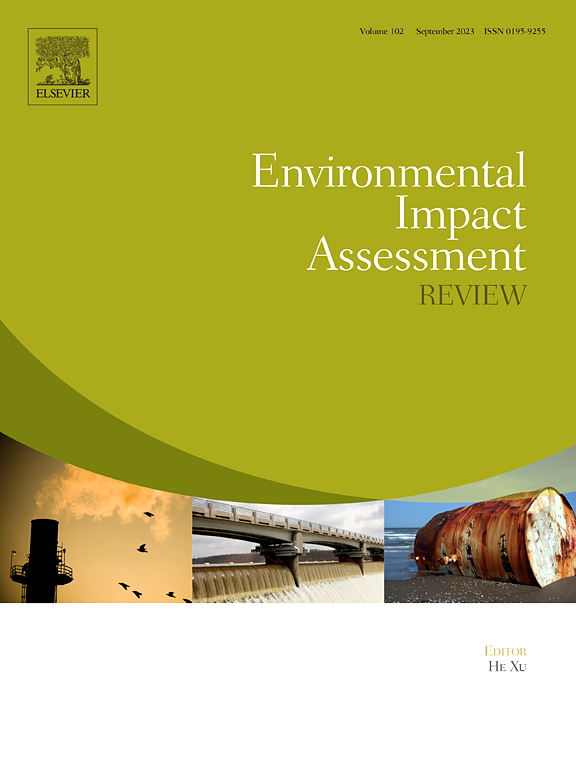如何评价深部采煤引起的地面沉降引起的景观变化?在Jastrzębie煤炭公司(波兰南部)矿区测试的方法
IF 9.8
1区 社会学
Q1 ENVIRONMENTAL STUDIES
引用次数: 0
摘要
地面沉降是煤矿开采最严重的影响之一,在波兰的上西里西亚(Upper Silesia)尤其普遍,其不利影响是众所周知的。根据波兰法律,有意开采煤炭的公司必须在特许经营申请过程中提供相关文件。这包括对环境条件的决定-环境影响评估(EIA)。环评的一个重要组成部分是景观影响评估(LIA),它审查景观的变化,包括潜在的视觉和物理影响。本文介绍了一种评估开采后沉陷导致的景观变化的方法,该方法是为Jastrzębska煤炭公司获得采矿特许权所需的环境影响评估报告而开发的。该方法包括对景观结构的分析(景观单元的划分),确定自然、文化和视觉价值,以及评估由于下沉而导致的未来景观变化。利用视域范围分析和确定景观单元内沉降引起的景观变化的尺度,对两种变量的变化进行了评估。这项研究包括制图分析、统计计算和以地图形式呈现的可视化。结果表明,视觉值(可视范围)会增大。预计在几个区域会对划定的景观单元产生重大影响,包括下沉达到11.5米,这将影响到变体1中高达94%的景观单元面积和变体2中80%的景观单元面积。该方法的创新之处在于使用定量方法来分析景观变化,以确保评估的最大客观性,并实施数字尺度来描述由于地面沉降而导致的景观变化。本文章由计算机程序翻译,如有差异,请以英文原文为准。
How to assess landscape changes caused by land subsidence due to deep coal mining? Methodology tested in the mining area of Jastrzębie coal company (Southern Poland)
Land subsidence is among the most significant impacts of coal mining, posing a particularly prevalent challenge in Upper Silesia, Poland, where its adverse effects are well-recognized. Under Polish law, companies intending to mine coal must provide documentation as part of the concession application process. This includes a decision on environmental conditions - Environmental Impact Assessment (EIA). A critical component of the EIA is the Landscape Impact Assessment (LIA), which examines changes to the landscape, including potential visual and physical impacts. This article presents a methodology for assessing landscape changes resulting from post-mining subsidence, developed for the EIA report required to secure a mining concession for Jastrzębska Coal Company. The methodology includes an analysis of the landscape structure (delimitation of landscape units), identifying natural, cultural and visual values, and evaluating future landscape changes due to the subsidence. The changes are assessed for two variants using viewshed range analysis and by determining the scale of landscape changes caused by subsidence within the landscape units. The study involved cartographic analysis, statistical calculations, and visualizations presented as maps. The results suggest that visual values (viewshed range) will increase. A significant impact on the delimited landscape units is anticipated in several areas, including subsidence reaching 11,5 m, which will affect up to 94 % of the area of the landscape units in Variant 1 and 80 % in Variant 2. The innovation of the methodology is using the quantitative methods employed for analyzing view changes to ensure maximum objectivity in the assessment and implementing a numerical scale for describing landscape changes due the land subsidence.
求助全文
通过发布文献求助,成功后即可免费获取论文全文。
去求助
来源期刊

Environmental Impact Assessment Review
ENVIRONMENTAL STUDIES-
CiteScore
12.60
自引率
10.10%
发文量
200
审稿时长
33 days
期刊介绍:
Environmental Impact Assessment Review is an interdisciplinary journal that serves a global audience of practitioners, policymakers, and academics involved in assessing the environmental impact of policies, projects, processes, and products. The journal focuses on innovative theory and practice in environmental impact assessment (EIA). Papers are expected to present innovative ideas, be topical, and coherent. The journal emphasizes concepts, methods, techniques, approaches, and systems related to EIA theory and practice.
 求助内容:
求助内容: 应助结果提醒方式:
应助结果提醒方式:


